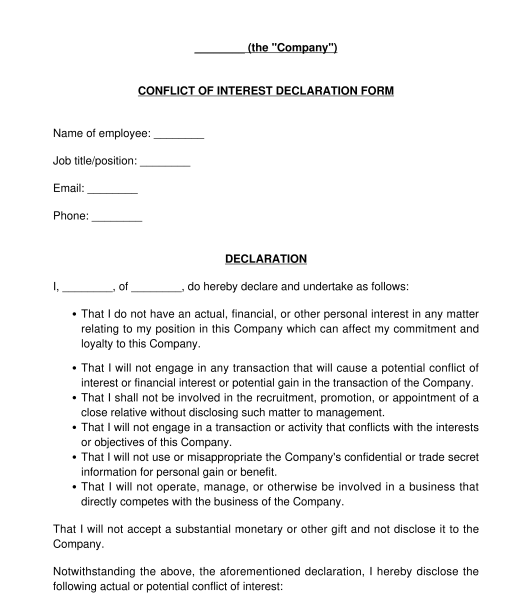 12/09/2025
12/09/2025

Answer a few questions and your document is created automatically.

Your document is ready! You will receive it in Word and PDF formats. You will be able to modify it.

 12/09/2025
12/09/2025
 Word and PDF
Word and PDF
 2 to 3 pages
2 to 3 pages



A Conflict of Interest Declaration Form is a formal document that an employee must complete to disclose any potential conflicts of interest they might have in a specific situation or role. Conflicts of interest arise when an employee or a staff of an organization has personal loyalties or interests that can potentially affect their ability to make an objective decision.
Examples of possible conflicts of interest which an employee may disclose to their employer include, but are not limited to the following:
This document can be used to disclose any conflicts of interest or declare the absence of such conflicts and can be used together with a Conflict of Interest Policy.
This document allows employees to be open and disclose all potential conflicts of interest to keep their employer informed. The form typically consists of sections where individuals can indicate any financial interests, relationships, or affiliations that could potentially create a conflict between their personal interests and professional obligations. This includes financial connections, family associations, partnerships, or other relevant links.
The form is important because it serves as proof that the conflict of interest was disclosed. Even if someone mentioned the conflict verbally, it's crucial to have a written record. This way, if any issues arise later on, everyone can show that the proper procedures were followed.
This document can be used in two ways. An employee can either fill out all the relevant details directly or choose to print the document and provide the details later. If the first option is preferred, enter the necessary personal information and provide a comprehensive description of any conflicts of interest.
If the second option is preferred, the form will be generated with empty spaces for the employee's name, contact details, and description of the conflict(s) of interest. The employer can also save this form as a template and provide it to their employees who need to make a conflict of interest declaration.
Regardless of the chosen option, once an employee has completed the form and made their declaration, they can sign it and submit it to their employer, usually the human resources officer or someone in charge of employee affairs in the employer's organization. The employer will then keep the signed form for record-keeping purposes.
Several laws in Nigeria require persons to declare conflicts of interest. Examples of these laws include the following:
You fill out a form. The document is created before your eyes as you respond to the questions.
At the end, you receive it in Word and PDF formats. You can modify it and reuse it.
Conflict of Interest Declaration Form - FREE - template
Country: Nigeria